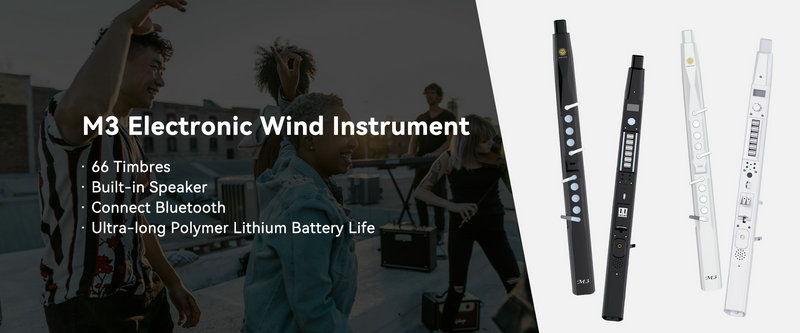The M3 Electronic Wind Instrument offers four inherent fingering options, each designed to mimic the fingering system of different traditional wind instruments. Here's how you can use these fingering options to play different instrument sounds:
Flute Fingering:
This fingering is designed for players who are familiar with the traditional flute.
It uses the same key layout and fingering patterns as a standard flute, making it easy for flute players to transition to the M3.
To use the flute fingering, select it via the function knob and play the keys as you would on a flute.
Electric Flute Fingering:
This fingering is similar to the flute but may have some adjustments to suit the nuances of electric flute playing.
It can offer a more contemporary sound compared to the traditional flute, and the fingering might be optimized for the specific timbres available on the M3.
Select the electric flute fingering from the settings and play using the corresponding fingering chart provided in the manual.
Electric Saxophone Fingering:
Designed for those who have experience with the saxophone, this fingering will feel familiar to sax players.
It replicates the saxophone's key layout and fingering patterns, which can help in achieving a sound that is close to an electric saxophone.
Choose the electric saxophone fingering in the settings and refer to the provided fingering chart to play the instrument.
Cucurbit Flute Fingering:
The cucurbit flute, also known as the "Hulusi" or "Tianluo," has a unique fingering system.
This fingering option allows the M3 to produce sounds similar to this traditional Chinese wind instrument.
Select the cucurbit flute fingering and use the specific fingering chart to play melodies that would be characteristic of the cucurbit flute.
To switch between these fingering options on the M3:
Locate the function knob or the relevant button on the M3.
Navigate to the fingering selection setting using the knob or button.
Choose the desired fingering option (Flute, Electric Flute, Electric Saxophone, or Cucurbit Flute) by rotating the function knob or pressing the assigned button.
Once the desired fingering is selected, you can play the instrument using the corresponding fingering chart.
It's important to practice with each fingering option and become familiar with the fingering chart for each to effectively play different instrument sounds on the M3 Electronic Wind Instrument. Additionally, experimenting with different timbres in conjunction with these fingering options can help you achieve a wide range of expressive sounds.
SUNRISE MELODY M3 Electronic Wind Instrument - The best-selling Electronic Wind Instrument
. 66 Timbres
. Built-in Speaker
. Connect Bluetooth
. Ultra-long Polymer Lithium Battery Life



